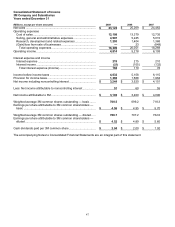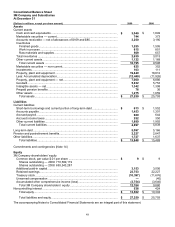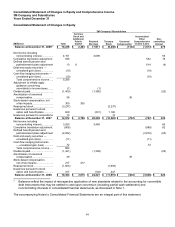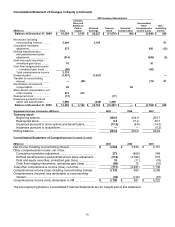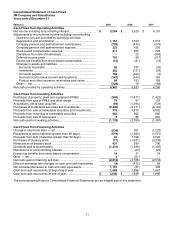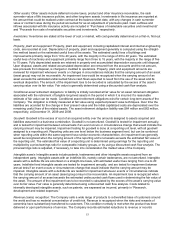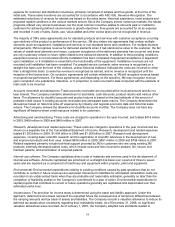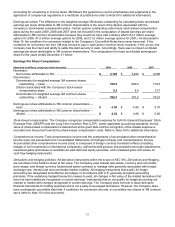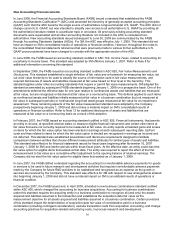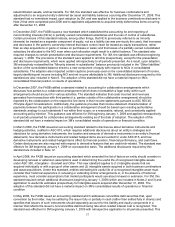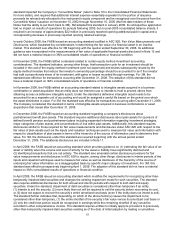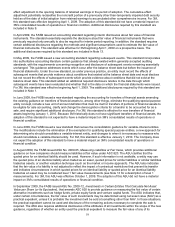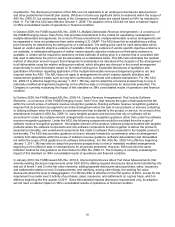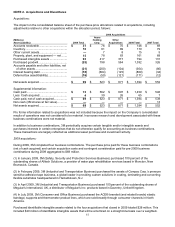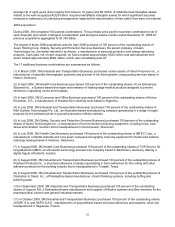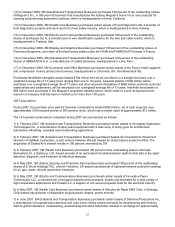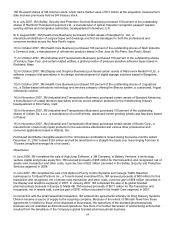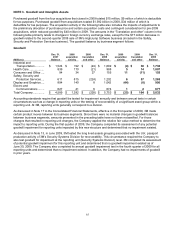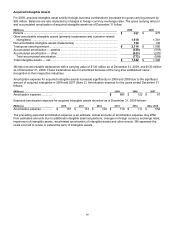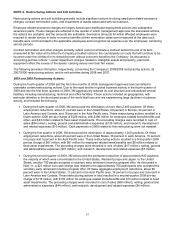3M 2009 Annual Report Download - page 63
Download and view the complete annual report
Please find page 63 of the 2009 3M annual report below. You can navigate through the pages in the report by either clicking on the pages listed below, or by using the keyword search tool below to find specific information within the annual report. 57
indemnification assets, and tax benefits. For 3M, this standard was effective for business combinations and
adjustments to an acquired entity’s deferred tax asset and liability balances occurring after December 31, 2008. This
standard had no immediate impact upon adoption by 3M, and was applied to the business combinations disclosed in
Note 2 that were completed post-2008 and to applicable adjustments to acquired entity deferred tax items occurring
after December 31, 2008.
In December 2007, the FASB issued a new standard which established the accounting for and reporting of
noncontrolling interests (NCIs) in partially owned consolidated subsidiaries and the loss of control of subsidiaries.
Certain provisions of this standard indicate, among other things, that NCIs (previously referred to as minority
interests) be treated as a separate component of equity, not as a liability (as was previously the case); that increases
and decreases in the parent’s ownership interest that leave control intact be treated as equity transactions, rather
than as step acquisitions or gains or losses on purchases or sales; and that losses of a partially owned consolidated
subsidiary be allocated to the NCI even when such allocation might result in a deficit balance. This standard also
required changes to certain presentation and disclosure requirements. For 3M, the standard was effective beginning
January 1, 2009. The provisions of the standard were applied to all NCIs prospectively, except for the presentation
and disclosure requirements, which were applied retrospectively to all periods presented. As a result, upon adoption,
3M retroactively reclassified the “Minority interest in subsidiaries” balance previously included in the “Other liabilities”
section of the consolidated balance sheet to a new component of equity with respect to NCIs in consolidated
subsidiaries. The adoption also impacted certain captions previously used on the consolidated statement of income,
largely identifying net income including NCI and net income attributable to 3M. Additional disclosures required by this
standard are also included in Note 6. The adoption of this standard did not have a material impact on 3M’s
consolidated financial position or results of operations.
In December 2007, the FASB ratified a standard related to accounting for collaborative arrangements which
discusses how parties to a collaborative arrangement (which does not establish a legal entity within such
arrangement) should account for various activities. The standard indicates that costs incurred and revenues
generated from transactions with third parties (i.e. parties outside of the collaborative arrangement) should be
reported by the collaborators on the respective line items in their income statements pursuant to ASC 605-45,
Principle Agent Considerations. Additionally, the guidance provides that income statement characterization of
payments between the participants in a collaborative arrangement should be based upon existing authoritative
standards; analogy to such standards if not within their scope; or a reasonable, rational, and consistently applied
accounting policy election. This guidance was effective for 3M beginning January 1, 2009 and applied retrospectively
to all periods presented for collaborative arrangements existing as of the date of adoption. The adoption of this
standard did not have a material impact on 3M’s consolidated results of operations or financial condition.
In March 2008, the FASB issued an accounting standard related to disclosures about derivative instruments and
hedging activities, codified in ASC 815, which requires additional disclosures about an entity’s strategies and
objectives for using derivative instruments; the location and amounts of derivative instruments in an entity’s financial
statements; how derivative instruments and related hedged items are accounted for under ASC 815, and how
derivative instruments and related hedged items affect its financial position, financial performance, and cash flows.
Certain disclosures are also required with respect to derivative features that are credit-risk-related. The standard was
effective for 3M beginning January 1, 2009 on a prospective basis. The additional disclosures required by this
standard are included in Note 12.
In April 2008, the FASB issued an accounting standard which amended the list of factors an entity should consider in
developing renewal or extension assumptions used in determining the useful life of recognized intangible assets
under ASC 350, Intangibles - Goodwill and Other. This new standard applies to (1) intangible assets that are
acquired individually or with a group of other assets and (2) intangible assets acquired in both business combinations
and asset acquisitions. Under this standard, entities estimating the useful life of a recognized intangible asset must
consider their historical experience in renewing or extending similar arrangements or, in the absence of historical
experience, must consider assumptions that market participants would use about renewal or extension. For 3M, this
standard required certain additional disclosures beginning January 1, 2009 (which are included in Notes 2 and 3) and
application to useful life estimates prospectively for intangible assets acquired after December 31, 2008. The
adoption of this standard did not have a material impact on 3M’s consolidated results of operations or financial
condition.
In May 2008, the FASB issued an accounting standard which addresses convertible debt securities that, upon
conversion by the holder, may be settled by the issuer fully or partially in cash (rather than settled fully in shares) and
specifies that issuers of such instruments should separately account for the liability and equity components in a
manner that reflects the issuer’s nonconvertible debt borrowing rate when related interest cost is recognized. This
standard was effective for 3M beginning January 1, 2009 with retrospective application to all periods presented. This


